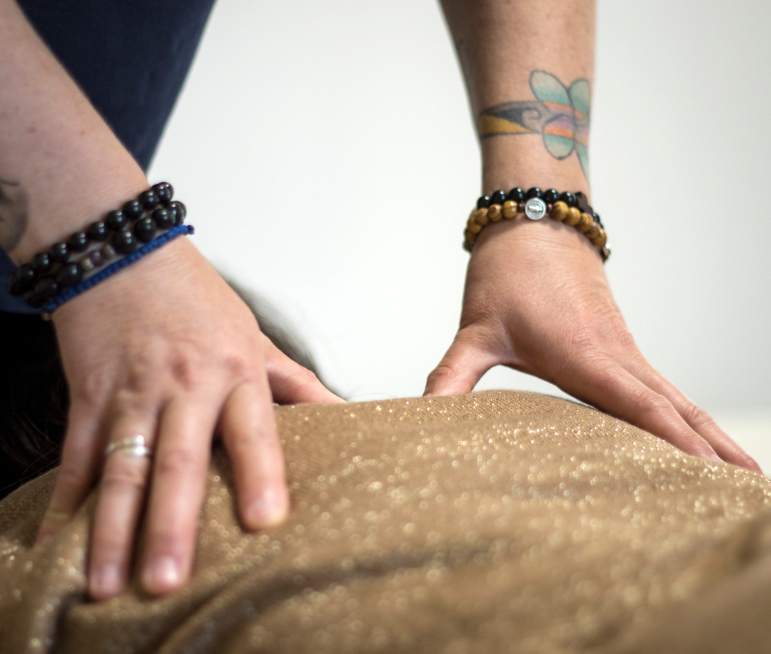
Discovering Shiatsu with Delphine Trouttet
Shiatsu and its benefits
Shiatsu, Japanese manual energy therapy, is a natural method of prevention and health maintenance. It works by awakening the body's natural self-healing abilities.
Shiatsu treats both physical pain and emotional imbalances, allowing you to learn to know yourself better, revealing the deepest tensions linked to the psyche.
It is practiced dressed in loose, comfortable clothing, on a massage table or on a futon .

The Shiatsu-ki practitioner uses specific techniques: pressure with thumbs, palms, elbows and knees along the energy meridians, but also stretching, mobilization, body vibration, he also stimulates acupuncture points to rebalance the Ki (Vital Energy). These pressures are constant and associated with listening to the body and an absence of muscular effort.
It is particularly effective for:
- stress, insomnia, fatigue
- burnout
- depression, depression, anxiety, anxiety
- back pain (sciatica, lumbago, etc.), joint pain (rheumatism, arthritis, etc.)
- digestive and intestinal problems (indigestion, heartburn, bloating, diarrhea, constipation, etc.)
- headaches (migraine, sinusitis, etc.)
- periods (pre-menstrual syndrome, heavy flow, etc.)
- colds (rhinitis, hay fever, etc.)
- blood circulation problems
Shiatsu is ideal for people who are uncomfortable with traditional massages, the use of oil, or who simply prefer to remain clothed during the treatment. This technique allows you to achieve physical, energetic and psychological well-being. The massaged person leaves with a calmer nervous system, better managed emotions and a lighter mind.
Progress of a session
A session lasts on average 1 hour and includes an interview of approximately 15 minutes. It generally consists of two complementary stages: an energy treatment, then the shiatsu itself. The ideal is to be able to combine them but, as the first step is not always expected by my clients, I may not offer it.
I only suggest this first step, which consists of an energetic treatment, based on my feelings about the client's openness to this approach. When I feel that the person is more reassured by a treatment carried out solely by touch, I only practice traditional shiatsu. This being very complete and relaxing, it is sufficient in itself when it meets the client's expectations.
As soon as I welcome the consultant, I carry out a brief interview allowing me to understand the reasons for his visit. These reasons can be multiple: physical pain, localized or widespread, occasional or recurring, or even feelings of heaviness in daily life, when managing stress or emotions becomes difficult for example.
Once these reasons are known, I take a Chinese pulse in order to orient myself more precisely. It sometimes happens that the person receiving treatment is not fully aware of what is affecting them, which is why this method allows me to know more about their ailments in order to act effectively to relieve them.
The protocol that I follow generally begins with a touch of the back, a place where a lot of emotions are concentrated. I then work from head to toe, in successive stages, targeting certain meridians. Indeed, shiatsu consists of work on the different acupuncture meridians of the body, I work on a broad plane while focusing my movements on these areas.

The session ends with a moment of relaxation allowing the person to fully relax and appreciate the benefits of the treatment.
Subsequently, a second session is recommended to complete this first treatment. I let my consultants come back to me after a few weeks once all the benefits have been felt, so that they can tell me if they wish to strengthen the treatment, or we directly agree on a new appointment within 3 or Next 4 weeks. It is also common for me to offer these sessions on a regular basis, monthly for example.
In more detail: what are meridians?
We call a meridian an axis connected to an organ, vital or not, and also connected to an emotion.
Re-harmonizing the meridians helps rebalance the organs, the functioning of which is often undermined by physical or psychological ailments.
There are 12 main meridians in the body that can be classified into two categories: yin, for the so-called “full” vital organs, essential to survival, and “yang”, for the so-called “hollow” organs.
The “yin” organs are the heart, lungs, liver, kidneys, spleen and pancreas.
The “yang” organs are the male organs, the large intestine, the small intestine, the stomach, the gallbladder and the bladder.
These organs are themselves associated with emotions and often reflect the discomfort felt.
For example :
- the lungs translate sadness, sorrow, depression
- the heart translates joy, love, emotional shocks
- the spleen, pancreas and stomach reflect rumination, lack of roots (emotions often translated by acid reflux, digestion difficulties)
- the liver translates anger, irritation, frustration and even hatred
- the kidneys transmit vital energy, courage, strength, but also fears (in the form of blockages preventing you from moving forward)
Two additional meridians are also essential for good physical and psychological balance: the heart master and the triple heater.
The heart master acts on the pericardium by calming emotions, nervousness, excitement and even hysteria. It also has an action on the libido. The triple heater acts on the parasympathetic nervous system and calms the effects of stress on it.
Energy care
We spoke above about the energy treatment offered as a first intention during shiatsu sessions. As this is a treatment focused solely on the etheric body, one may not feel open to this type of treatment at first glance. Here is what it is about in more detail, explained by Delphine, in order to better understand it.
To lay the foundations for energetic treatment, we must visualize our etheric body as a set of Russian dolls that we can fit into one another. Attempting to fit Russian dolls together by removing some of them can produce a wobbly, unstable effect. This is exactly what can happen in our Aura: if there is disharmony in these subtle bodies, the chakras will be impacted.
When the chakras are offset, it produces an imbalance that is felt both physically and psychologically. Physically, the person received may describe a sensation of floating, dizziness, or even the feeling sometimes of not being in their place. Psychologically, this results in a loss of direction, sometimes a feeling of being too full or of loss of control.
Realigning these chakras allows you to feel better grounded, while opening up spiritually. This realignment also helps to reclaim one's physical body or more simply, to find one's place here and now.
The treatment consists of movements carried out around the body, without touching it, acting only on the Aura. These movements are exercised for example at the level of the calves, allowing ancestral memories to be opened, freeing family memories to lighten their weight. By pulling the energy between the legs, the solar plexus, often overloaded with emotions, is deflated and breathing opens, generating true liberation.
In case of localized pain, these movements can be associated with the use of a tool which will act only in the etheric body, without ever touching the body. An etheric incision is made in the Aura at the site of the pain, allowing it to be quickly evacuated.
The chakras
These chakras that we often talk about when we talk about energetic well-being are a sometimes obscure concept. These chakras, seven in number, can be seen as localized points centralizing energy for a specific objective.
The first chakra, or Root chakra, is located at the feet, knees, hips, kidneys and perineum. It is the headquarters of:
- anchoring,
- roots,
- family,
- financial security,
- well-being on earth
- primary needs and, more broadly, survival.
The second chakra, or Sacral chakra, is located at the level of the reproductive system and the sciatic nerve. It is the headquarters of:
- the sensuality,
- sexuality,
- design,
- desire,
- pleasure, but also displeasure,
- vital energy,
- the energy devoted to carrying out certain actions.
The third chakra, or Solar Plexus chakra, is located in the digestive system and the pancreas. It is the seat:
- emotions,
- self-confidence,
- from the link to collective emotion,
- feeling the emotions of others,
- influence in society
The fourth chakra, or Heart, is located at the level of the heart, lungs, blood circulation and thymus. It hosts:
- love in the universal sense of the term
- the relationship with the divine
- the lower mind (ego)
- the upper mind (taking into account the Human)
The fifth chakra, or Throat chakra, is located in the throat, mouth, teeth, ears and thyroid. It is the headquarters of:
- Communication,
- the word, the verb,
- family belief,
- societal belief,
- the causal body, or cause and effect link,
- creation in the artistic sense, in association with the second chakra.
The sixth chakra, or Third Eye Chakra, is located at the level of the eyes, sinuses, base of the skull and pituitary gland. This third eye allows us to receive information from other dimensions, to “travel into other things”.
The seventh chakra, or Crown chakra, is located at the level of the cerebral cortex, the skin, the epiphysis and melatonin. It is the link to supreme consciousness, the universe, the divine and allows complete open-mindedness.
To conclude
Shiatsu is a very complete treatment dedicated both to people interested in the mechanical benefits of a treatment, as well as its spiritual aspect. These two aspects combine or dissociate in shiatsu, complementary but independent, in order to quickly contribute to your well-being.
To find out more and make an appointment, in Charente or Dordogne, you can contact Delphine Trouttet on 06 08 41 85 47, but also visit her website: https://zen-harmonie.jimdofree.com/
Products
View all
